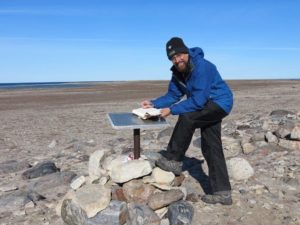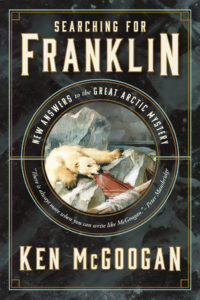Nunatsiaq News breaks Big Franklin story

‘I think I’ve figured it out’: Author prowls mystery of Franklin expedition.
In his new book, Ken McGoogan links parasites in bear meat to explorers’ deaths.
By Madalyn Howitt
For Arctic explorer Ken McGoogan, each trip he takes is a chance to fulfil a quest.
“I almost can’t travel anywhere without some kind of a mission,” he said, speaking by phone from his home in Guelph, Ont.
A former journalist who now sails with Adventure Canada as a resource historian, McGoogan has been involved in Arctic exploration for 25 years.
It started after he and late oral historian Louie Kamookak placed a plaque marking the location where explorer John Ray discovered the final link in the [first navigable] Northwest Passage.
McGoogan’s latest mission? Discovering what really happened on Sir John Franklin’s fateful 1845 expedition that led to the shipwrecks of HMS Erebus and HMS Terror and the eventual deaths of everyone onboard.
“It has taken me 25 years and six books to figure out what happened, on top of many visits into the Arctic that all came into play,” he said.
The cover of McGoogan’s latest book, Searching for Franklin: New Answers to the Great Arctic Mystery, depicts a polar bear tearing away remnants of the Franklin wreckages with its sharp teeth, hinting at McGoogan’s theory about what caused the catastrophe that befell Franklin’s last expedition.
So, did polar bears kill the men of the Franklin expedition? Not quite.
“Metaphorically, the polar bears did it, [but] it’s not quite the way it’s depicted there,” McGoogan laughed.
The real culprit? That would be trichinosis, he said. Searching for Franklin: New Answers to the Great Arctic Mystery is the latest book from Arctic explorer Ken McGoogan, examining what caused the deaths of over a hundred men on the shipwrecked 1845 Franklin expedition.
Trichinosis is a deadly food-borne disease caused by a microscopic parasite that people can get by eating raw or undercooked meat from animals infected with the parasite.
McGoogan proposes that when polar bears ventured near the stranded [sailors on Beechey Island], the crewmen shot them and put the meat into barrels along with their rations. Improper storage led to the meat becoming infected.
“When I put that together, I understood. I felt I had the final missing piece,” McGoogan said.
“The bears were coming there, they were shooting them, putting them into barrels, they thought it was fantastic,” he said.
“They thought, ‘We’re on our way, we got all this extra meat, we’re going to be going all the way to the Pacific Ocean.’ Of course, it didn’t happen that way.
“I think I figured it out. I honestly think that is the answer to it all,” McGoogan said.
While there is no physical proof to support his theory, that could be forthcoming if archeologists are able to retrieve evidence from the sunken wrecks as they have with other artifacts on recent diving trips.
“It’s amazing what they can determine if they get the right piece of evidence,” McGoogan said.
Part of the reason people keep going back to learn more about the mystery of the 1845 Franklin expedition is that it was “such an anomaly,” he said.
Just a few years [later], an Arctic expedition led by Robert McClure also got stuck in the ice. They were there for two years and seven months before he started to take radical measures. But he lost virtually no men, McGoogan said.
In contrast, by the time the shipwrecked Franklin expedition had been in the ice for one year and seven months, dozens of men were already dead including Franklin himself.
The captain [was hailed] by many as a hero of Arctic exploration, despite having led at least two disastrous expeditions and ignoring the advice of Indigenous guides along the way.
McGoogan challenges that historical depiction in his book. He will discuss the book and more about Arctic exploration in Ottawa on Wednesday night at the Royal Canadian Geographical Society.
“I just love the whole process [of writing]. There’s a dialogue happening, going back and forth as I write,” he said.
McGoogan, after all, loves an adventure.
“Part of my mission is to make history exciting again.”
Searching for Franklin: New Answers to the Great Arctic Mystery is available from Douglas & McIntyre.
It’s John Rae. Your welcome.
Christian Rae